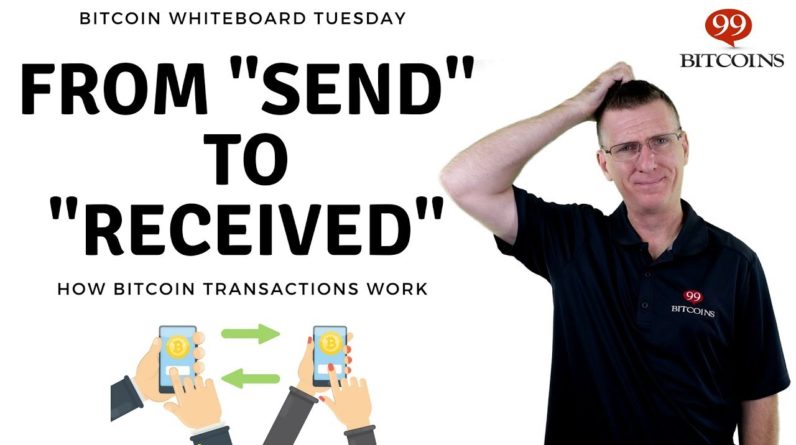
What is shorting Bitcoin? Is there a way to make money from Bitcoin
even when I think its price is going to drop? And how can I do that
if I don’t own any Bitcoins? Well, stick around, in this episode
of Crypto whiteboard Tuesday we’ll answer these questions and more. Hi, I’m Nate Martin
from 99Bitcoins.com and welcome to
Crypto Whiteboard Tuesday where we take complex
cryptocurrency topics, break them down
and translate them into plain English. Before we begin,
don't forget to subscribe to the channel and click the bell
so you’ll immediately get notified when a new video comes out. Today’s topic is short selling Bitcoin.
Short selling (often referred to as just ‘shorting’)
is an investment method for making money when you expect an asset’s price to drop. It’s called “short selling” because you are short, meaning you don’t actually have any of the
asset you want to sell in order to turn a profit. Keep in mind that neither I nor anyone
on the 99Bitcoins team is a financial advisor, and this video shouldn't be
considered financial advice. The purpose of this lesson
is to explain short selling as a tool. It’s available in various markets,
and is also available for cryptocurrencies, so I want you to better understand what it is. Basically, shorting works by
borrowing an asset, such as Bitcoin, and selling it at its current price. Later on, you’ll need to purchase those Bitcoins
back in order to repay the person or company from whom you borrowed them. Hopefully, by the time you go to buy those
Bitcoins back, prices will have dropped, and you will have spent less money to purchase the assets that need to be paid back
than what you received when you sold them.
Let's illustrate this with an a example: Imagine you short sell 10 Bitcoins
when the price of a Bitcoin is $10,000. This means you borrow 10 Bitcoins and turn
around and sell them, receiving $100,000. This nets you the $100,000
while leaving you 10 Bitcoins short. Now fortunately, some time after you sell the
coins, the price of Bitcoin drops to $8,000. You see your chance and repurchase
those 10 Bitcoins for a total of $80,000 and then take those 10 Bitcoins back to the person from whom you borrowed them. When all is said and done,
using no money or assets of your own, you’ve made a profit of $20,000.
Hang on!…Don’t go applying
for a trading account just yet! Keep in mind that when you short-sell,
the entity that loaned the Bitcoins to you can generally require that you pay back
those assets at any given time. They’re only required to give you
a short amount of time as notice. This means you may be required
to return the Bitcoins before the price has dropped
to the desired level. Sure, the further the price drops,
the cheaper it will be to buy these 10 Bitcoins back and
the bigger your profit would be. But, what happens if
Bitcoin’s price were to go up? The maximum profit of a short is limited to how much you make if Bitcoin’s price goes to 0, meaning you get to keep all of the profit because don’t need any money to buy back the Bitcoins. But there is no upper limit to
how much you could lose when shorting. Let’s talk about that for a minute… Normally, when you invest in an asset,
your losses are limited to the amount of money you used to buy that asset.
Say you invest $10,000 dollars in a stock, and that stock suddenly collapses
and becomes worthless: Well, your losses will be limited
to the $10,000 dollars you initially put up. When short selling, however, your losses could
extend far beyond your initial investment, something that is very important to consider,
especially with a volatile asset like Bitcoin. Let’s go to another example: Let's say you short-sold
$10,000 worth of Bitcoin back when the price was
only $1,000 per coin. But you have yet to repurchase those coins, meaning that you still have to
pay the owner back those 10 Bitcoins.
Now imagine that all of a sudden
prices shoot up to $10,000, which can definitely happen
given Bitcoin’s volatile nature. This means that the 10 Bitcoins you need to
pay back is now going to cost you $100,000! And if there are other traders who are in
the same type of short position as you are, they’ll want to close their short positions by
buying back the Bitcoins they borrowed – applying even more buying pressure to the
market, causing an even bigger price increase. This is known as the short squeeze. As you can see,
short-selling can be extremely risky. If you’re just starting out with Bitcoin,
or any other asset for that matter, you’ll probably want to avoid short selling
until you’ve gained some trading experience. Now that you know what short selling is,
let’s take a deeper look at how it’s done.
To short Bitcoins,
you need to find a trading platform that will allow you to place a short sell order. Today there are a variety
of ways to short Bitcoin. The first option is through CFD trading. CFD stands for Contract for Difference. It means that instead of
actually borrowing Bitcoins, selling them and then buying
them back at a lower price you agree to just settle on the difference. So in the case of CFDs you will get
paid the difference if the price drops without needing to go through all of the hassle of selling and then buying the coins back… Companies like eToro, Plus500 and others
supply cryptocurrency CFD services that allow you to short sell Bitcoin. Keep in mind that CFD trading
carries a high level of risk and is really only suitable
for experienced traders as the majority of people trading
CFDs end up losing their money. If you don’t want to use a CFD service you
can short sell Bitcoins through an exchange. Bitcoin exchanges that are geared towards
crypto traders offer short selling options, and some allow for leveraged shorting as well.
Leveraged shorting means
you can borrow more money from the exchange than you
actually have deposited there, in order to buy the Bitcoins you want to short. For example, say you have
$1,000 on the exchange and you leverage on a 1:3 ratio,
giving you the ability to short sell up to $3,000, which is 3 times what you have. Leveraging is considered even more risky
since if things don’t go as you intended, the exchange might close your trade itself, sooner than you expected – because they know
you’re using money you don’t really own. If you’re leveraging at a 1:3 ratio,
any move in the market has triple the effect. So if Bitcoin were go to up by $400
you actually lose $1,200. In other words,
leveraging magnifies both gains and losses. If you stand to lose more than the $1000
you have deposited with the exchange, they’ll close the position
once you hit the $1000 mark rather than risk having to try to collect
additional funds from you in the future.
Some of the major exchanges that allow you to
short sell Bitcoin include Bitfinex and Kraken. And, some specialized exchanges, such as
BitMEX, also offer Bitcoin options trading. Purchase of an option grants the ability,
but not the obligation, to trade at a specific price
by a specific date. If you have experience with options trading
this method might suit you, otherwise it’s not recommended for beginners. Options are complex but do allow for
greater flexibility and higher leverage. If you want to learn more about
the services I’ve just mentioned take a look at the links below this video. Ok, so when is a good time to short sell? Well, if you examine the Bitcoin price charts,
you’ll soon realize the truth of the old saying, “price takes the stairs up
and the elevator down.” Whereas uptrends take time
to build and develop, downtrends tend to be
relatively short and sharp.
However, if you still want to
take a shot at timing the market, beyond technical analysis which is
explained in our Bitcoin trading video, it helps to have a solid knowledge
of the Bitcoin space. Different types of events have
different effects on Bitcoin’s price. For example, there were major price drops following the failure of major exchanges like Mt.
Gox or BTC-e. Also, news of hostile regulatory
actions in major countries such as the Bitcoin bans in China,
or the SEC clampdowns on ICOs, tends to cause the price of Bitcoin
to move downwards. Changes in the Bitcoin development team,
such as the exit of lead developer Mike Hearn, for example; has also resulted in price drops. Other examples of past events that dropped
Bitcoin’s price include the Bitcoin Cash fork and delays or setbacks in widely-desired
upgrades like SegWit or the Lightning Network. If you had shorted Bitcoin prior to these events
you would have made you a lot of money. So from examining these examples,
we can learn some clues for potential shorting opportunities; So, does this mean that we can foresee the
effect of some event on Bitcoin’s price? Not necessarily.
Some events that many would have believed
to cause a change in Bitcoin’s price have had no effect at all. For example, the failure of darknet markets such as Silk Road or Alpha Bay resulted in much less dramatic drops
than some expected. Claims of having unmasked
the identity of Satoshi Nakomoto as in the case of Dorian Nakomoto or
Craig Wright also resulted in little to no impact. Additionally, media FUD, which stands for Fear Uncertainty and Doubt about Bitcoin, has had less and less effect
on the markets of late. After nearly 400 Bitcoin obituaries, new reports of Bitcoin’s imminent demise
aren’t given much credence anymore. To conclude, short selling,
risky though it may be, is actually very common in the trading
of stocks and in other financial markets, and increasingly now in crypto. Just make sure you read any rules, regulations,
or guidelines for “covering” any assets you short sell so you’ll know
exactly what you’re getting into. If you’re just starting out,
gain some experience with regular trading before moving into more
complex methods like shorting.
And as always,
never invest amounts you can’t afford to lose. That’s it for today’s episode of
Crypto Whiteboard Tuesday. Hopefully by now you understand
what shorting Bitcoin is – A way to profit from Bitcoin’s price drops. You may still have some questions. If so, just leave them in
the comment section below. And if you’re watching this video on YouTube, and enjoy what you’ve seen, don’t forget to hit the like button. Then make sure to subscribe
to the channel and click that bell so that you’ll be notified
as soon as we post a new episode. Thanks for joining me here at the Whiteboard. For 99bitcoins.com,
I’m Nate Martin, and I’ll see you…in a bit..




